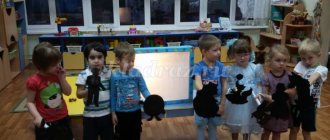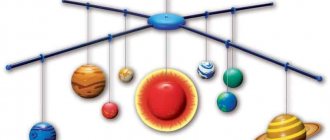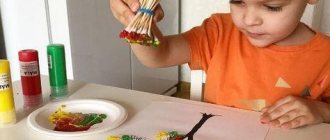Creative play in the educational process of preschool educational institutions
The main activity of preschool children is play, during which the child’s spiritual and physical strengths develop: creative activity, imagination, attention, discipline, dexterity, independence, etc. In addition, this is a unique way of assimilating social experience, characteristic of preschool age. The game represents a child’s attempt to organize his experience, his personal world.
In the context of the implementation of the Federal State Educational Standard, children are taught through play, because play is the main content of the life and activity of a preschooler. Play is the most accessible type of activity. In games, preschoolers reproduce in roles everything that they see from the world around them; they are called creative or plot-based role-playing games. Creative play most fully shapes a child’s personality, and therefore is an important means of education. The game is a reflection of life. Playing “make-believe” in this environment, which is created by the child’s imagination, there is a lot of reality: the actions of the players are real. The child knows that the doll is a toy, but loves it as if it were alive, understands that he is not a “true” rescuer, but feels like a brave and courageous rescuer who is not afraid of danger.
Imitating adults in play is associated with the work of the child’s imagination; he combines impressions from life with personal experience. In the game, children simultaneously act as decorators, playwrights, and actors. Preparing for a game does not require a long time like an actor. They play it with the thoughts and feelings that they have at the moment.
In play, children interact with peers. They are united by common interests and a common goal. In play, the child feels like a member of a team and fairly evaluates his actions and the actions of his comrades. Collective creative game - school for educating preschoolers. Moral qualities formed in the game influence the child’s behavior in life.
Play is an important means of mental education for a child. In play, children's mental activity is always associated with the work of their imagination: choosing the role of the person they want to imitate, imagining how to act. It also develops imagination in finding the means to accomplish what is planned: before you go to rescue, you need to build equipment and select the right tool, and if you don’t have one, make it yourself. This is how the game develops the creative abilities of the future schoolchild.
Games create a cheerful and joyful mood in children, make the child’s life full and rich, even with adequate nutrition, he will develop poorly if he is deprived of games.
Play prepares children for work. Because reflects the work of adults: children imitate the work of a doctor, teacher, salesman, etc. Consequently, respect for work is cultivated.
The game is closely related to the artistic creativity of a preschooler. As the game story progresses, children sing, dance, and recite familiar poems.
Story-based role-playing games are closely related to theatrical games. Both are based on the reflection of events, actions and relationships between people. However, theatrical games are based on the dramatization of based literary works or their own dramatizations adapted for performance on the stage.
The content of modern children's games is varied: they reflect the life of the family, the work of professions, political and social events that are understandable to the child and attract his attention.
Thus, creative play is an important means of all-round development of children, associated with all types of their activities and for preparing the child for the future, and in order to make his life full and happy - one of the most important tasks
Question: can and should a teacher interfere in the yoke? There is such a right if it is required to give the game the desired direction, without violating their plans, to make the game more exciting.
In conclusion, I would like to say once again about the plot - role-playing is a creative activity and has a great impact on the development of the child, in contrast to direct educational activities, there is no place for a pedagogical directive in the game, but there is a place for partnership and the creator of various play centers that will ensure the comprehensive development of the child taking into account educational areas.
Online Games
1
Catch the cat. A game
Catch the Cat is a great game for testing your ability to solve non-standard problems, as well as a good opportunity to practice your skills in finding creative solutions. This online flash game was developed by the famous Japanese design laboratory Gamedesign (gamedesign.jp) and has the original name “Chat Noir” (“Black Cat” in French). Play
2
Droodles
The essence of the game is that you are asked to describe a picture that has multiple meanings. A doodle picture is something like a scribble and is similar to what a student or schoolboy usually draws mechanically on paper during a lecture or lesson. However, in droodle, the authors initially provide for the variability of its interpretation. Try to use your creativity in solving doodles.
3
IQ Ball
“IQ Ball” is an interesting online flash game that is perfect for both children and adults. By playing it, you will learn how to find non-trivial and most effective solutions, which is necessary for any person who wants to develop their creative skills. Play.
4
Memory Matrix
The game “Memory Matrix” is well known to everyone from applications for Nokia phones. There are also many analogues for different platforms. Here we invite you to play the classic version of this simple flash game, which is great for training memory and concentration, which is also important for developing creativity. Play.
5
8 queens
8 queens is one of the most famous chess problems. Finding an answer to the question of how to place 8 queens on a chessboard at the same time will be useful for everyone who wants to develop their intellectual abilities, find solutions to non-standard problems, and think through moves in search of an answer. After all, even in this seemingly logical chess puzzle, all the answers can only be found with the help of a creative approach. Play.
Offline games
6
Game "Let's write..."
Within a minute, try to name as many things as possible that are currently in the room with you and begin with the letter: “K.” The letter “P”... And the letter “B”? Count how much you got. If you try, you can name more than 50 things, or even more than 100. To improve this exercise, think about what groups of surrounding objects you forgot to include.
For example, starting with the letter “B” you can name:
- things, hanger, (items);
- screws, introduction to the book on the shelf, (details of objects);
- tungsten lamp filaments, felt, cotton wool, viscose, etc. (materials);
- pile on the carpet, wax on the parquet (coating);
- hair, eyelids, freckles, temples, etc. (body);
- imagination, delight, excitement, the ability to come up with something else (mental concepts);
- air, breeze, variants of words, yourself, everyone else (also with “v”).
Think what else can be called? Practice with other letters: “p”, “k”, “s” - easier, “d”, “a”, “t” - more difficult.
7
"Complete the drawing"
This game can be played by two or by a large group. The rules are that one person draws, without looking at the paper, several lines or a figure, and the second person must complete it as creatively as possible so that a complete picture is obtained. Then the players change.
8
Burime
Burime has already won an army of fans for quite a long time (the game has been known since the 17th century) and remains popular among lovers of an interesting and useful pastime. Today, from the last desks of schools and universities, it has moved to the Internet, where you can always find someone to play with.
The essence of this creative literary game is the collective writing of poetry. All you need is company, a piece of paper and a pencil. There are several options for burime. In the classical version, the rhymes and themes of the future verse are agreed upon in advance. They try to choose unexpected, contrasting rhymes, while avoiding auxiliary words, pronouns, cognates and verb forms (tide, gone, come), as well as hackneyed expressions (love-blood, April-drops).
A more cheerful variety of burime, loved by students, is the writing of humorous rhymes. Sometimes also called the “game of nonsense.” It is played like this: the first participant writes a line or several (the funnier and more senseless, the better) and folds over part of the sheet with what was written, after which the second participant continues, but knows only the last word or line written by the previous one. The end result is a rather funny poem.
9
Hat
Hat is a team intellectual creative game for guessing words. In stores you can often find the board game “Hat”, with pre-prepared cards with words and explanations. But you can play it without special props, and the rules are quite simple.
A minimum of 2 pairs of players is required to play. Everyone writes 10 words on a piece of paper, after which they are all mixed in a hat (hence the name, but you can use any material at hand for this purpose). Words must be common nouns in the nominative case, by agreement - fictitious names, etc. Then the presenter or the players themselves time 30 (for experienced 20) seconds - the end. During the con, the team (pair) must guess as many words as possible. One takes out a card, reads to himself and tries to explain to the second what the word is written on it. In this case, it is prohibited:
- Use of cognate words (the word “corral” cannot be explained using the word “drive”). If the hidden word is multi-rooted, then not a single root can be used in the explanation.
- Using direct translations of words or their roots into other languages (you cannot explain the word “dining room” using the word “table”)
- Using direct translations of the roots of foreign words (the word “liberal” cannot be explained using the word “freedom”)
- Using gestures (including pointing to objects)
- Use of consonant words (the word “tavern” cannot be explained using the words “tobacco” or “boar”).
You can use similar-sounding words, synonyms, lengthy explanations, metaphors and other techniques that do not contradict the above rules. At the same time, words that are consonant with the meaning also need to be explained, and not named directly. When the team guesses the word, they get the next piece of paper. After 30 seconds, the second team enters the game and so on alternately until all the words have been guessed. The pair that guesses the most words wins.
There is also a three-round version of the game. The first goes as in the original game, in the second those same cards need to be guessed using one word and pantomime, and in the third - only with the help of pantomime (gestures).
10
Creative TRIZ game for children
There is a special section in the Theory of Inventive Problem Solving - TRIZ pedagogy. Its goal is to educate from preschool age a personality capable of solving open-ended problems. The TRIZ training program is built, among other things, on the use of various games and exercises that help develop imagination, associative thinking, and logic. Here is an example of one such game; more can be found in books and resources, the list of which is here.
Give your child a piece of paper and a pencil. Turn on some light music, ask them to close their eyes and draw whatever they want, without thinking about shape or location. Let it be several drawings that overlap each other. Afterwards, with your eyes open and colored pencils, try together to find the most bizarre images at the junction of what you have drawn and color them.
11
Education Ways
In domestic preschool pedagogy, a classification of children's games has developed, based on the degree of independence and creativity of children in the game. Initially, P.F. approached the classification of games according to this principle. Lesgaft, later his idea was developed in the works of N.K. Krupskaya.
She divides all children's games into 2 groups. The first N.K. Krupskaya called them creative; emphasizing their main feature - independent character. This name has been preserved in traditional domestic preschool pedagogy for the classification of children's games. Another group of games in this classification are games with rules.
Modern domestic pedagogy classifies role-playing, construction and theatrical games as creative games. The group of games with rules includes didactic and outdoor games.
Theatrical play is very closely related to the plot-role-playing game and is its variety. Role-playing play appears in a child at approximately 3 years of age and reaches its peak at 5-6 years of age; theatrical play reaches its peak at 6-7 years of age.
As a child grows up, he goes through a number of stages, and his play also develops step by step: from experimenting with objects, familiarizing himself with them to displaying actions with toys and objects, then the first plots appear, then role-playing is added and, finally, dramatization of plots.
D.B. Elkonin calls role-playing play a creative activity in which children take on and in a generalized form reproduce the activities and relationships of adults, using substitute objects. Theatrical play appears at a certain period and, as it were, grows out of the plot-role-playing game. This happens at a time when, at an older age, children are not satisfied only with reproducing the plots of real relationships between adults. Children become interested in basing the game on literary works, revealing their feelings in it, making dreams come true, performing desired actions, acting out fantastic plots, and inventing stories.
Role-playing game and theatrical play have a common structure (structure). They include substitutions, plot, content, game situation, role, role-playing actions.
Creativity is manifested in these types of games in the fact that children creatively produce everything that they see around them: the child conveys his feelings in the depicted phenomenon, creatively implements the idea, varies his behavior in the role, and uses objects and substitutes in the game in his own way.
The difference between plot-role-playing and theatrical games is that in plot-role-playing games children reflect life phenomena, and in theatrical ones they take plots from literary works. In a role-playing game there is no final product, the result of the game, but in a theatrical game there can be such a product - a staged performance, a staging.
Due to the fact that both types of games, role-playing and theatrical, belong to creative types, the concept of creativity should be defined. According to encyclopedic literature, creativity is something new, something that has never happened before. Thus, creativity is characterized by 2 main criteria: novelty and originality of the product. Can children's creative products meet these criteria? Certainly not. N.A. Vetlugina, a prominent researcher of children's artistic creativity, believes that in his creativity a child discovers new things about himself, and tells others new things about himself.
Consequently, the product of children's creativity has not objective, but subjective novelty. The remarkable scientist teacher T.S. Komarova understands a child’s artistic creativity as “the child’s creation of a subjectively new (meaningful for the child, first of all) product (drawing, modeling, story, dance, song, game, invented by the child), inventing new ones for the unknown, previously unused details that characterize the image being created in a new way (in a drawing, in a story, etc.), inventing your own beginning, end of new actions, characteristics of heroes, etc., using previously learned methods of depiction or means of expression in a new situation (for depicting objects of a familiar shape - based on mastery of facial expressions, gestures, voice variations, etc.), the child’s showing initiative in everything, coming up with different options for images, situations, movements, as well as the very process of creating images of a fairy tale, story, game - dramatization, drawing, etc., searching in the process of activity for ways to solve a problem (visual, playful, musical).
Indeed, in the game the child comes up with a lot himself. He comes up with the idea and content of the game, selects visual and expressive means, and organizes the game. In the game, the child manifests himself as an artist acting out the plot, and as a screenwriter, building its outline, and as a decorator, arranging a place for the game, and as a designer, embodying a technical project.
Go to page: 1
MAGAZINE Preschooler.RF
“Modern approaches to organizing creative games for preschoolers”The play activity of preschool children is a significant social phenomenon in which the development and culture of society as a whole are noticeably reflected.
During the game, the child reproduces models of adult life, work and relationships, takes on real social roles, and also realizes his cognitive, aesthetic and moral needs. It is the game that allows the child to reduce the existing contradictions between his desire to be a full participant in the adult world and the real opportunities available. If appropriate play practice is not accumulated in preschool childhood, the child's social development may be complicated.
A game is an activity that takes place on two levels. On the one hand, the game takes place in a conditional situation and contains a number of conditional elements. The child utters the words “as if” and finds himself in a completely different world - in a space rocket, in a raging ocean... The child believes that he is in the magical world of the game, and, at the same time, understands that he is “here and now” .
A game is a symbolic activity, since real objects in it are replaced by symbols - objects or actions that replace real ones. The ability to use symbols in one’s activities is one of the universal human abilities, and its development occurs in the game.
The game carries a feeling of freedom. Perhaps, for a preschooler, this is the only activity in which he enjoys freedom and can choose what to play, who to play with, how long to play, what toys to take.
Having analyzed the choice of plots and roles, I noted that in the games of preschool children, not only traditional plots that have existed for a long time are preserved, but also many new game roles appear. This includes Batman, Spider-Man, and other cartoon and movie heroes. But I also noted the appearance of new negative characters, anti-heroes (zombies, vampires, etc.) in the children’s game. I associate this with a characteristic feature of the subculture of modern childhood, which is formed under the influence of the media, the availability of various computer games, and simply the inattention of adults to what their children are doing, what films and television programs they watch.
Modern toys occupy a special place in children's games. A bright, diverse, not always understandable to an adult, often useless and non-developing toy is a characteristic sign of our time. Often the game comes down to hoarding, because having as many as possible of those toys that are popular at the moment is considered prestigious in the children's subculture.
The most preferred game with toys for girls is “Barbie and Ken”, where girls give free rein to their imagination, using attributes specially created for the Barbie world - furniture, clothes, animals, vehicles. However, despite the abundance of toys and attributes for role-playing games, the plots of creative games are quite monotonous. In an imaginary situation, the girls act in accordance with the retelling of the plot seen on TV and do not allow the character and name of the hero to change. The role-playing behavior of game participants is characterized by a lack of novelty and variability. Children solve game problems in familiar ways.
In the creative games of children in the pre-school group, I take indirect guidance. Indirect leadership techniques should provide the child with the position of a participant in those events that he learns about in the process of observations, listening to books, watching cartoons and films. The indirect development of the game should ensure the development of a positive, emotionally charged attitude of children towards the phenomena of the surrounding reality, which can be reflected in the game. To do this, I try to enrich children’s ideas about social reality through excursions, reading books, conversations, didactic games, etc. I provide the child with the position of a participant in those events that he learns about in the process of observing, listening to stories, reading books, watching movies and cartoons.
The organization of creative games is associated with the creation of a developing object-based play environment, in which we present both ready-made games and toys, as well as materials for synthesizing play with artistic and labor activity, allowing you to include homemade products in the game and combine play with drawing.
In order to more effectively carry out indirect management of play, I observe children’s play behavior, study the possibilities of its development, and try to determine how to awaken the children’s activity and initiative.
To enrich the themes of children's creative games, the subject-developmental environment in our group was replenished. Attributes were selected for the role-playing game “Airfield” , “Sea Voyage” . The children gladly helped me make equipment for the game and made their suggestions, which turned out to be quite creative. This is how we got a “mission control center” , “captain’s cabin” , “laboratory” .
To enrich the content of the games, I used various methods: story, explanation, showing presentations, looking at illustrations, organizing targeted observation, conversations, questions. After acquiring and systematizing knowledge on the topics “Airfield” and “Sea Voyage,” children’s role-playing dialogues were significantly enriched, and a certain freedom in role-playing actions appeared. Children began to combine several plots into one and come up with new developments for the game.
Children react very subtly to whether I see what they are doing and whether I notice their play. They are very sensitive to my reaction, and if I support and approve their actions, the children’s activity increases, friendly comments and tips are taken for granted.
I believe that the work of a teacher in developing the creative play of preschoolers should not be limited only to pedagogical influence directly on children. In activating creative activity, in developing initiative, in enriching with imaginative artistic impressions, family conditions also play an important role. Not only in kindergarten, but also at home, the child should have favorable conditions for the development of his creative initiative.
Creative games promote the transition of children's curiosity into inquisitiveness, the development of observation, the development of imagination, ingenuity, ingenuity, memory and speech. Any game has enormous developmental potential. The game not only shapes the child’s personality, but also prepares him for adult life, helps him quickly and successfully integrate into a new team, it reflects everything that the child sees in everyday life, it demonstrates his attitude to social reality, worldview, so it is difficult to overestimate the importance games in preschool childhood.
MBDOU "Kindergarten No. 1"
Prepared by: Maria Valerievna Kurgannikova 2016
| Next > |
Types of games for preschoolers and their role in children's development consultation (senior group) on the topic
The game occupies a strong place in the system of physical, moral, labor and aesthetic education of preschool children. It activates the child, helps increase her vitality, satisfies personal interests and social needs. Considering the invaluable role of play in the life of preschoolers, I would like to dwell on this issue in more detail.
The problem of the game is widely covered in scientific and methodological literature (in the works of D. V. Mendzheritskaya, D. B. Elkonin, L. S. Vygotsky, L. P. Usova, A. I. Sorokina, R. I. Zhukovskaya, L. V. Artyomova and other classic authors).
A child’s personal qualities are formed in active activities, and above all in those activities that become leading at each age stage and determine his interests, attitude to reality, and the characteristics of relationships with people around him. In preschool age, such a leading activity is play. Already at early and junior age levels, it is in play that children have the greatest opportunity to be independent, to communicate with peers at will, to realize and deepen their knowledge and skills. The older children become, the higher the level of their general development and education, the more significant is the pedagogical focus of the game on the formation of behavior, relationships between children, and the development of an active position. The game gradually develops purposefulness of actions. If in the second and third years of life children begin to play without thinking, and the choice of game is determined by the toy that catches their eye and by imitation of their friends, then later children are taught to set goals in construction games, and then in games with toys. In the fourth year of life, the child is able to move from thought to action, i.e. able to determine what he wants to play, who he will be. But even at this age, children often have a predominant interest in action, which is why the goal is sometimes forgotten. However, already at this age, children can be taught not only to deliberately choose a game, set a goal, but also to distribute roles. At first, the prospect of the game is short - arrange a Christmas tree for the dolls, take them to the dacha. It is important that the imagination of every child is aimed at achieving this goal. Under the guidance of the teacher, children gradually learn to determine a certain sequence of actions and outline the general course of the game.
There are several classes of games:
· creative (games initiated by children);
· didactic (games initiated by adults with ready-made rules);
· folk (created by the people) .
Creative games make up the most rich typical group of games for preschoolers. They are called creative because children independently determine the purpose, content and rules of the game, most often depicting the life around them, human activities and relationships between people.
Creative play is essential for a child's all-round development. Through playful activities, children strive to satisfy their active interest in the life around them and transform into adult heroes of works of art. Thus creating a playful life, children believe in its truth, are sincerely happy, sad, and worried.
Creative play teaches children to think about how to implement a particular idea. Creative play develops valuable qualities for a future student: activity, independence, self-organization.
Creative games:
- Plot-role-playing (with elements of labor, with elements of artistic and creative activity).
- Theatrical activities (directing, games - dramatization).
- Design.
A plot-based role-playing creative game is the first test of social forces and their first test. A significant part of creative games are plot-based - role-playing games with “someone” or “something”. Children develop interest in creative role-playing games from the age of 3-4 years. The child’s reflection of the surrounding reality occurs in the process of his active life, by taking on a certain role, but he does not imitate completely, because he does not have real opportunities to actually perform the operations of the accepted role. This is due to the level of knowledge and skills, life experience at a given age stage, as well as the ability to navigate familiar and new situations. Therefore, in a creative plot-role-playing game, he performs symbolic actions (“as if”), replaces real objects with toys or conditionally with those objects that he has, attributing to them the necessary functions (a stick is a “horse”, a sandbox is a “steamer”, etc.). d.) Children portray people, animals, the work of a doctor, hairdresser, driver, etc. Understanding that the game is not real life, children at the same time truly experience their roles, openly show their attitude to life, their thoughts, feelings , perceiving the game as an important and responsible matter.
The structure of a role-playing game, according to D.B. Elkonin, includes the following components:
- The roles that children take on during the game.
- Play actions through which children realize the roles they have taken on and the relationships between them.
- Playful use of objects, conditional replacement of real objects at the child’s disposal.
- Real relationships between playing children, expressed in various remarks, through which the entire course of the game is regulated.
Saturated with vivid emotional experiences, role-playing game leaves a deep imprint in the child’s mind, which will be reflected in his attitude towards people, their work, and life in general. Under the influence of enriching the content of games, the nature of relationships between children changes. Their games become cooperative, based on a common interest in them; the level of children's relationships increases. For children at play, coordination of actions, preliminary selection of a topic, a calmer distribution of roles and game material, and mutual assistance during the game become characteristic.
In addition, increasing the level of role relationships helps to improve real relationships, provided that the role is performed at a good level.
However, there is also a feedback - role relationships become higher under the influence of successful, good relationships in the group. A child performs his role in the game much better if he feels that the children trust him and treat him well. This leads to a conclusion about the importance of choosing partners and the teacher’s positive assessment of the merits of each child.
Theatrical activity is one of the types of creative play activity, which is associated with the perception of works of theatrical art and the depiction of received ideas, feelings, and emotions in a playful form. They are divided into 2 main groups: director's games and dramatization games.
In the director's game, the child, as a director and at the same time a voice-over, organizes a theatrical playing field in which dolls are the actors and performers. In another case, the actors, scriptwriters and directors are the children themselves, who during the game agree on who plays what role and what they do.
Dramatization games are created based on a ready-made plot from a literary work or theatrical performance. The game plan and sequence of actions are determined in advance. Such a game is more difficult for children than inheriting what they see in life, because you need to well understand and feel the images of the characters, their behavior, remember the text of the work (sequence, unfolding of actions, character remarks), this is the special meaning of games – dramatization – they help children better understand the idea of a work, feel its artistic value, and have a positive effect on the development of expressive speech and movements.
Children's creativity is especially clearly manifested in games - dramatizations.
In order for children to be able to convey the appropriate image, they need to develop their imagination, learn to put themselves in the place of the heroes of the work, to be imbued with their feelings and experiences.
In the process of work, children develop their imagination, form speech, intonation, facial expressions, and motor skills (gestures, gait, posture, movements). Children learn to combine movement and speech in roles, develop a sense of partnership and creativity.
Another type is construction games . These creative games direct the child’s attention to different types of construction, contribute to the acquisition of organizational design skills, and attract them to work. In construction games, children’s interest in the properties of an object and their desire to learn how to work with it are clearly demonstrated. The material for these games can be construction sets of different types and sizes, natural material (sand, clay, cones, etc.), from which children create various things, according to their own plans or on the instructions of the teacher. It is very important that the teacher helps students make the transition from aimlessly piling up material to creating thoughtful structures.
In the process of construction games, the child actively and constantly creates something new. And he sees the results of his work. Children should have enough building material, different designs and sizes.
Material for construction games:
- Natural material (leaves, cones, snow, clay, sand)
- Artificial material (mosaic, paper, modular blocks, construction sets of various types and sizes).
With all the variety of creative games, they have common features: children, independently or with the help of an adult (especially in dramatization games), choose the theme of the game, develop its plot, distribute roles among themselves, and choose the necessary toys. All this should happen under the tactful guidance of an adult, aimed at activating children’s initiative and developing their creative imagination.
Games with rules. These games provide an opportunity to systematically train children in developing certain habits; they are very important for physical and mental development, character development and willpower. Without such games, it would be difficult to carry out educational work in kindergarten. Children learn games with rules from adults and from each other. Many of them are passed down from generation to generation, but educators, when choosing a game, must take into account the requirements of our time.
According to the content and conduct of games with rules, they are divided into two groups: didactic and mobile.
Didactic games mainly contribute to the development of children’s mental abilities, since they contain a mental task, the solution of which is the meaning of the game. They also contribute to the development of senses, attention, and logical thinking. A prerequisite for a didactic game are rules, without which the activity becomes spontaneous.
In a well-designed game, it is the rules, not the teachers, that guide children's behavior. The rules help all participants in the game to be and act in the same conditions (children receive a certain amount of material, determine the sequence of actions of the players, and outline the range of activities of each participant).
A didactic game is a multifaceted, complex pedagogical phenomenon: it is a gaming method of teaching preschool children, a form of education, an independent gaming activity, and a means of comprehensive education of a child.
Didactic games, as a gaming method of teaching, are considered in two forms:
· Games - activities;
· Didactic games.
In a game-activity, the leading role belongs to the teacher, who, in order to increase children’s interest in the activity:
· Uses a variety of gaming techniques that create a game situation;
· Creates a game situation;
· Uses various components of gaming activities;
· Transfers certain knowledge to students;
· Forms children’s ideas about the construction of a game plot, about various game actions with objects, teaches them to play;
· Creates conditions for transferring acquired knowledge and ideas to
independent creative games.
The didactic game is used in teaching children, in various classes and outside of them (physical education, mental education, moral education, aesthetic education, labor education, development of communication skills).






